Design of Silicon Nanowire Array for PEDOT:PSS-Silicon Nanowire-Based Hybrid Solar Cell
Abstract
1. Introduction
2. General Design of SiNW
2.1. p-n Junction Design
2.2. Vertically Aligned or Blended SiNW
2.3. Fabrication of SiNW
2.4. Reduction of Surface Trap States
2.5. Doping of SiNWs
2.6. Removing SiNW Agglomeration
- By using low surface tension solvent: As agglomeration of SiNW is a direct function of solvent used during etching process, therefore low surface tension solvents instead of water ( surface tension = 75.64 mN/m) are used to avoid agglomeration during the etching process [97]. These solvents are generally ethanol (surface-tension = 22.27 mN/m), methanol (surface-tension = 22.6 mN/m), n-hexane (surface-tension = 18.4 mN/m), n-octane (surface-tension = 21.8 mN/m), etc.
- Post-treatment after fabrication of SiNWs: In this method agglomerated SiNW are separated either by wet or dry etching treatment. In wet etching technique, Potassium Hydroxide (KOH) or Tetra Methyl Ammonium Hydroxide (TMAH) solution is used to taper the top agglomerated bundle of nanowire. Generally, KOH is the better option as compared to the TMAH [98,99]. In dry etching method, the agglomerated SiNW are separated by passing them through a dry-phase post plasma treatment in an RIE system, but the main drawback of this method is the creation of defects on the surface of SiNW.
- Togonal method: Togonal et al. has proposed a simple two step process for the fabrication of SiNW by etching method which can improve the top agglomeration of SiNWs. In the first step, the Si substrate is hydropholically pre-treated before the etching process and then the already developed SiNW array is hydrophobically post-treated in the second step. It is well-reported that these steps can lead to the formation of SiNW array with high density and larger nanowire-length with very little agglomeration [100].
2.7. Large Area Application
2.8. Stability of Hybrid Solar Cell
3. Electrical Design of SiNW for Hybrid Solar Cell
3.1. Diode-Ideality Factor
3.2. Shunt Resistance
3.3. Series Resistance
4. Optical Response of SiNW for PEDOT:PSS–SiNW Solar Cell
5. Photovoltaic Design of SiNW
5.1. Photovoltaic Mechanism of PEDOT:PSS–SiNW Hybrid Solar Cells
5.2. Effects of SiNW’s Surface Traps
5.3. Improvement in PV Response
5.4. Improvement in
5.5. Improvement in
6. Conclusions
Author Contributions
Funding
Acknowledgments
Conflicts of Interest
References
- Shafiee, S.; Topal, E. When will fossil fuel reserves be diminished? Energy Policy 2009, 37, 181–189. [Google Scholar] [CrossRef]
- Klinenberg, E.; Araos, M.; Koslov, L. Sociology and the Climate Crisis. Annu. Rev. Sociol. 2020, 46. [Google Scholar] [CrossRef]
- Sun, X.; Li, Z.; Wang, X.; Li, C. Technology development of electric vehicles: A review. Energies 2020, 13, 90. [Google Scholar] [CrossRef]
- Harrington, R. This Incredible Fact Should Get You Psyched About Solar Power. Bus. Insid. 2015. Available online: http://www.businessinsider.com/solar-power-potential-how-much-energy-does-sun-have-2017-3 (accessed on 23 July 2020).
- Lee, T.D.; Ebong, A.U. A review of thin film solar cell technologies and challenges. Renew. Sustain. Energy Rev. 2017, 70, 1286–1297. [Google Scholar] [CrossRef]
- Alivisatos, A.P. Semiconductor clusters, nanocrystals, and quantum dots. Science 1996, 271, 933–937. [Google Scholar] [CrossRef]
- Law, M.; Goldberger, J.; Yang, P. Semiconductor nanowires and nanotubes. Annu. Rev. Mater. Res. 2004, 34, 83–122. [Google Scholar] [CrossRef]
- Garnett, E.; Yang, P. Light trapping in silicon nanowire solar cells. Nano Lett. 2010, 10, 1082–1087. [Google Scholar] [CrossRef]
- Wang, J.; Polizzi, E.; Lundstrom, M. A three-dimensional quantum simulation of silicon nanowire transistors with the effective-mass approximation. J. Appl. Phys. 2004, 96, 2192–2203. [Google Scholar] [CrossRef]
- Paska, Y.; Haick, H. Interactive effect of hysteresis and surface chemistry on gated silicon nanowire gas sensors. ACS Appl. Mater. Interfaces 2012, 4, 2604–2617. [Google Scholar] [CrossRef]
- Zhang, A.; Kim, H.; Cheng, J.; Lo, Y.H. Ultrahigh responsivity visible and infrared detection using silicon nanowire phototransistors. Nano Lett. 2010, 10, 2117–2120. [Google Scholar] [CrossRef]
- Zhang, G.J.; Ning, Y. Silicon nanowire biosensor and its applications in disease diagnostics: A review. Anal. Chim. Acta 2012, 749, 1–15. [Google Scholar] [CrossRef] [PubMed]
- Li, Q.; Koo, S.M.; Edelstein, M.D.; Suehle, J.S.; Richter, C.A. Silicon nanowire electromechanical switches for logic device application. Nanotechnology 2007, 18, 315202. [Google Scholar] [CrossRef]
- Karki, K.; Epstein, E.; Cho, J.H.; Jia, Z.; Li, T.; Picraux, S.T.; Wang, C.; Cumings, J. Lithium-assisted electrochemical welding in silicon nanowire battery electrodes. Nano Lett. 2012, 12, 1392–1397. [Google Scholar] [CrossRef] [PubMed]
- Yang, X.; Zhong, H.; Zhu, Y.; Jiang, H.; Shen, J.; Huang, J.; Li, C. Highly efficient reusable catalyst based on silicon nanowire arrays decorated with copper nanoparticles. J. Mater. Chem. 2014, 2, 9040–9047. [Google Scholar] [CrossRef]
- Dong, G.; Liu, F.; Liu, J.; Zhang, H.; Zhu, M. Realization of radial pn junction silicon nanowire solar cell based on low-temperature and shallow phosphorus doping. Nanoscale Res. Lett. 2013, 8, 544. [Google Scholar] [CrossRef]
- Garnett, E.C.; Yang, P. Silicon nanowire radial p- n junction solar cells. J. Am. Chem. Soc. 2008, 130, 9224–9225. [Google Scholar] [CrossRef]
- Grancini, G.; Maiuri, M.; Fazzi, D.; Petrozza, A.; Egelhaaf, H.J.; Brida, D.; Cerullo, G.; Lanzani, G. Hot exciton dissociation in polymer solar cells. Nat. Mater. 2013, 12, 29–33. [Google Scholar] [CrossRef]
- Stübinger, T.; Brütting, W. Exciton diffusion and optical interference in organic donor–acceptor photovoltaic cells. J. Appl. Phys. 2001, 90, 3632–3641. [Google Scholar] [CrossRef]
- Yaffe, O.; Chernikov, A.; Norman, Z.M.; Zhong, Y.; Velauthapillai, A.; van der Zande, A.; Owen, J.S.; Heinz, T.F. Excitons in ultrathin organic-inorganic perovskite crystals. Phys. Rev. 2015, 92, 045414. [Google Scholar] [CrossRef]
- Wu, B.; Wu, X.; Guan, C.; Tai, K.F.; Yeow, E.K.L.; Fan, H.J.; Mathews, N.; Sum, T.C. Uncovering loss mechanisms in silver nanoparticle-blended plasmonic organic solar cells. Nat. Commun. 2013, 4, 1–7. [Google Scholar] [CrossRef]
- Lee, J.M.; Kwon, B.H.; Park, H.I.; Kim, H.; Kim, M.G.; Park, J.S.; Kim, E.S.; Yoo, S.; Jeon, D.Y.; Kim, S.O. Exciton Dissociation and Charge-Transport Enhancement in Organic Solar Cells with Quantum-Dot/N-doped CNT Hybrid Nanomaterials. Adv. Mater. 2013, 25, 2011–2017. [Google Scholar] [CrossRef] [PubMed]
- Liu, J.; Wang, S.; Bian, Z.; Shan, M.; Huang, C. Organic/inorganic hybrid solar cells with vertically oriented ZnO nanowires. Appl. Phys. Lett. 2009, 94, 173107. [Google Scholar] [CrossRef]
- Novotny, C.J.; Yu, E.T.; Yu, P.K. InP nanowire/polymer hybrid photodiode. Nano Lett. 2008, 8, 775–779. [Google Scholar] [CrossRef] [PubMed]
- Chang, C.Y.; Tsao, F.C.; Pan, C.J.; Chi, G.C.; Wang, H.T.; Chen, J.J.; Ren, F.; Norton, D.; Pearton, S.; Chen, K.H.; et al. Electroluminescence from ZnO nanowire/polymer composite p-n junction. Appl. Phys. Lett. 2006, 88, 173503. [Google Scholar] [CrossRef]
- Bach-Toledo, L.; Hryniewicz, B.M.; Marchesi, L.F.; Dall’Antonia, L.H.; Vidotti, M.; Wolfart, F. Conducting polymers and composites nanowires for energy devices: A brief review. Mater. Sci. Energy Technol. 2020, 3, 78–90. [Google Scholar] [CrossRef]
- Hu, L.; Song, J.; Yin, X.; Su, Z.; Li, Z. Research progress on polymer solar cells based on PEDOT: PSS electrodes. Polymers 2020, 12, 145. [Google Scholar] [CrossRef]
- Moiz, S.A.; Karimov, K.; Ahmed, M. Electrical Characterization of Novel Organic Semiconductor: Materials and Devices for Sensor Technology; VDM Publishing: Saarbrucken, Germany, 2010. [Google Scholar]
- Moiz, S.A.; Alahmadi, A.N.M.; Karimov, K.S. Improved anode material for orange-dye as organic semiconductor. Optoelectron. Adv. Mater. Commun. 2020, 14, 61–65. [Google Scholar]
- Moiz, S.A.; Khan, I.A.; Younis, W.A.; Karimov, K.S. Space Charge–Limited Current Model for Polymers. Conduct. Polym. 2016, 91. [Google Scholar] [CrossRef]
- Jiang, X.; Xiong, Q.; Nam, S.; Qian, F.; Li, Y.; Lieber, C.M. InAs/InP radial nanowire heterostructures as high electron mobility devices. Nano Lett. 2007, 7, 3214–3218. [Google Scholar] [CrossRef]
- Um, H.D.; Moiz, S.A.; Park, K.T.; Jung, J.Y.; Jee, S.W.; Ahn, C.H.; Kim, D.C.; Cho, H.K.; Kim, D.W.; Lee, J.H. Highly selective spectral response with enhanced responsivity of n-ZnO/p-Si radial heterojunction nanowire photodiodes. Appl. Phys. Lett. 2011, 98, 033102. [Google Scholar] [CrossRef]
- Kempa, T.J.; Tian, B.; Kim, D.R.; Hu, J.; Zheng, X.; Lieber, C.M. Single and tandem axial pin nanowire photovoltaic devices. Nano Lett. 2008, 8, 3456–3460. [Google Scholar] [CrossRef] [PubMed]
- Perraud, S.; Poncet, S.; Noël, S.; Levis, M.; Faucherand, P.; Rouvière, E.; Thony, P.; Jaussaud, C.; Delsol, R. Full process for integrating silicon nanowire arrays into solar cells. Sol. Energy Mater. Sol. Cells 2009, 93, 1568–1571. [Google Scholar] [CrossRef]
- Moiz, S.A.; Nahhas, A.M.; Um, H.D.; Jee, S.W.; Cho, H.K.; Kim, S.W.; Lee, J.H. A stamped PEDOT: PSS–silicon nanowire hybrid solar cell. Nanotechnology 2012, 23, 145401. [Google Scholar] [CrossRef] [PubMed]
- Zhang, T.; Iqbal, S.; Zhang, X.Y.; Wu, W.; Su, D.; Zhou, H.L. Recent advances in highly efficient organic-silicon hybrid solar cells. Sol. Energy Mater. Sol. Cells 2020, 204, 110245. [Google Scholar] [CrossRef]
- Huang, C.H.; Chen, Z.Y.; Chiu, C.L.; Huang, T.T.; Meng, H.F.; Yu, P. Surface Micro-/Nanotextured Hybrid PEDOT: PSS-Silicon Photovoltaic Cells Employing Kirigami Graphene. ACS Appl. Mater. Interfaces 2019, 11, 29901–29909. [Google Scholar] [CrossRef]
- Lu, W.; Wang, C.; Yue, W.; Chen, L. Si/PEDOT: PSS core/shell nanowire arrays for efficient hybrid solar cells. Nanoscale 2011, 3, 3631–3634. [Google Scholar] [CrossRef]
- Eisenhawer, B.; Sensfuss, S.; Sivakov, V.; Pietsch, M.; Andrä, G.; Falk, F. Increasing the efficiency of polymer solar cells by silicon nanowires. Nanotechnology 2011, 22, 315401. [Google Scholar] [CrossRef]
- Lu, W.; Chen, Q.; Peng, Y.; Zhang, S.; Pang, T.; Zhang, T.; Luo, F.; Yan, L.; Wang, X. Improved silicon/PEDOT: PSS core/shell nanowire hetero-junction for organic–inorganic hybrid solar cells. Jpn. J. Appl. Phys. 2019, 58, 020907. [Google Scholar] [CrossRef]
- Chen, T.G.; Huang, B.Y.; Chen, E.C.; Yu, P.; Meng, H.F. Micro-textured conductive polymer/silicon heterojunction photovoltaic devices with high efficiency. Appl. Phys. Lett. 2012, 101, 033301. [Google Scholar] [CrossRef]
- Avasthi, S.; Lee, S.; Loo, Y.L.; Sturm, J.C. Role of majority and minority carrier barriers silicon/organic hybrid heterojunction solar cells. Adv. Mater. 2011, 23, 5762–5766. [Google Scholar] [CrossRef]
- Ali, G.; Shinde, S.S.; Sami, A.; Kim, S.H.; Wagh, N.K.; Lee, J.H. Effect of Interfacial Passivation on Inverted Pyramid Silicon/Poly (3, 4-ethylenedioxythiophene): Poly (styrenesulfonate) Heterojunction Solar Cells. Thin Solid Film. 2020, 138139. [Google Scholar] [CrossRef]
- Liu, Y.; Zhang, Z.G.; Xia, Z.; Zhang, J.; Liu, Y.; Liang, F.; Li, Y.; Song, T.; Yu, X.; Lee, S.T.; et al. High performance nanostructured silicon–organic quasi p–n junction solar cells via low-temperature deposited hole and electron selective layer. ACS Nano 2016, 10, 704–712. [Google Scholar] [CrossRef] [PubMed]
- Yu, X.; Shen, X.; Mu, X.; Zhang, J.; Sun, B.; Zeng, L.; Yang, L.; Wu, Y.; He, H.; Yang, D. High efficiency organic/silicon-nanowire hybrid solar cells: Significance of strong inversion layer. Sci. Rep. 2015, 5, 17371. [Google Scholar] [CrossRef] [PubMed]
- Shen, X.; Sun, B.; Liu, D.; Lee, S.T. Hybrid heterojunction solar cell based on organic–inorganic silicon nanowire array architecture. J. Am. Chem. Soc. 2011, 133, 19408–19415. [Google Scholar] [CrossRef] [PubMed]
- Pudasaini, P.R.; Ruiz-Zepeda, F.; Sharma, M.; Elam, D.; Ponce, A.; Ayon, A.A. High efficiency hybrid silicon nanopillar–polymer solar cells. ACS Appl. Mater. Interfaces 2013, 5, 9620–9627. [Google Scholar] [CrossRef]
- Anh, N.N.; Van Chuc, N.; Thang, B.H.; Van Nhat, P.; Hao, N.; Phuong, D.D.; Minh, P.N.; Subramani, T.; Fukata, N.; Van Trinh, P. Solar Cell Based on Hybrid Structural SiNW/Poly (3, 4 ethylenedioxythiophene): Poly (styrenesulfonate)/Graphene. Glob. Challenges 2020, 2000010. [Google Scholar] [CrossRef]
- Zhang, Y.; Cui, W.; Zhu, Y.; Zu, F.; Liao, L.; Lee, S.T.; Sun, B. High efficiency hybrid PEDOT: PSS/nanostructured silicon Schottky junction solar cells by doping-free rear contact. Energy Environ. Sci. 2015, 8, 297–302. [Google Scholar] [CrossRef]
- Yu, P.; Tsai, C.Y.; Chang, J.K.; Lai, C.C.; Chen, P.H.; Lai, Y.C.; Tsai, P.T.; Li, M.C.; Pan, H.T.; Huang, Y.Y.; et al. 13% efficiency hybrid organic/silicon-nanowire heterojunction solar cell via interface engineering. ACS Nano 2013, 7, 10780–10787. [Google Scholar] [CrossRef]
- Jiang, Y.; Gong, X.; Qin, R.; Liu, H.; Xia, C.; Ma, H. Efficiency enhancement mechanism for poly (3, 4-ethylenedioxythiophene): Poly (styrenesulfonate)/silicon nanowires hybrid solar cells using alkali treatment. Nanoscale Res. Lett. 2016, 11, 1–7. [Google Scholar] [CrossRef]
- Yu, P.; Wu, J.; Liu, S.; Xiong, J.; Jagadish, C.; Wang, Z.M. Design and fabrication of silicon nanowires towards efficient solar cells. Nano Today 2016, 11, 704–737. [Google Scholar] [CrossRef]
- Hobbs, R.G.; Petkov, N.; Holmes, J.D. Semiconductor nanowire fabrication by bottom-up and top-down paradigms. Chem. Mater. 2012, 24, 1975–1991. [Google Scholar] [CrossRef]
- Xia, Y.; Yang, P.; Sun, Y.; Wu, Y.; Mayers, B.; Gates, B.; Yin, Y.; Kim, F.; Yan, H. One-dimensional nanostructures: Synthesis, characterization, and applications. Adv. Mater. 2003, 15, 353–389. [Google Scholar] [CrossRef]
- Westwater, J.; Gosain, D.; Tomiya, S.; Usui, S.; Ruda, H. Growth of silicon nanowires via gold/silane vapor–liquid–solid reaction. J. Vac. Sci. Technol. Microelectron. Nanometer Struct. Process. Meas. Phenom. 1997, 15, 554–557. [Google Scholar] [CrossRef]
- Wagner, R.; Ellis, W. Vapor-liquid-solid mechanism of single crystal growth. Appl. Phys. Lett. 1964, 4, 89–90. [Google Scholar] [CrossRef]
- Hofmann, S.; Ducati, C.; Neill, R.; Piscanec, S.; Ferrari, A.; Geng, J.; Dunin-Borkowski, R.; Robertson, J. Gold catalyzed growth of silicon nanowires by plasma enhanced chemical vapor deposition. J. Appl. Phys. 2003, 94, 6005–6012. [Google Scholar] [CrossRef]
- Jee, S.W.; Kim, J.; Jung, J.Y.; Um, H.D.; Moiz, S.A.; Yoo, B.; Cho, H.K.; Park, Y.C.; Lee, J.H. Ni-catalyzed growth of silicon wire arrays for a Schottky diode. Appl. Phys. Lett. 2010, 97, 042103. [Google Scholar] [CrossRef]
- Fuhrmann, B.; Leipner, H.S.; Höche, H.R.; Schubert, L.; Werner, P.; Gösele, U. Ordered arrays of silicon nanowires produced by nanosphere lithography and molecular beam epitaxy. Nano Lett. 2005, 5, 2524–2527. [Google Scholar] [CrossRef]
- Zhang, Y.; Tang, Y.; Wang, N.; Yu, D.; Lee, C.; Bello, I.; Lee, S. Silicon nanowires prepared by laser ablation at high temperature. Appl. Phys. Lett. 1998, 72, 1835–1837. [Google Scholar] [CrossRef]
- Niu, J.; Sha, J.; Yang, D. Silicon nanowires fabricated by thermal evaporation of silicon monoxide. Phys. Low-Dimens. Syst. Nanostruct. 2004, 23, 131–134. [Google Scholar] [CrossRef]
- Zhang, R.Q.; Lifshitz, Y.; Lee, S.T. Oxide-assisted growth of semiconducting nanowires. Adv. Mater. 2003, 15, 635–640. [Google Scholar] [CrossRef]
- Lew, K.K.; Reuther, C.; Carim, A.H.; Redwing, J.M.; Martin, B.R. Template-directed vapor–liquid–solid growth of silicon nanowires. J. Vac. Sci. Technol. Microelectron. Nanometer Struct. Process. Meas. Phenom. 2002, 20, 389–392. [Google Scholar] [CrossRef]
- Martínez, R.V.; Martínez, J.; Garcia, R. Silicon nanowire circuits fabricated by AFM oxidation nanolithography. Nanotechnology 2010, 21, 245301. [Google Scholar] [CrossRef] [PubMed]
- Fu, Y.Q.; Colli, A.; Fasoli, A.; Luo, J.; Flewitt, A.; Ferrari, A.; Milne, W. Deep reactive ion etching as a tool for nanostructure fabrication. J. Vac. Sci. Technol. Microelectron. Nanometer Struct. Process. Meas. Phenom. 2009, 27, 1520–1526. [Google Scholar] [CrossRef]
- Li, X.; Bohn, P. Metal-assisted chemical etching in HF/H2O2 produces porous silicon. Appl. Phys. Lett. 2000, 77, 2572–2574. [Google Scholar] [CrossRef]
- Guo, Z.; Jung, J.Y.; Zhou, K.; Xiao, Y.; Jee, S.w.; Moiz, S.; Lee, J.H. Optical properties of silicon nanowires array fabricated by metal-assisted electroless etching. In Proceedings of the Next Generation (Nano) Photonic and Cell Technologies for Solar Energy Conversion, International Society for Optics and Photonics, San Diego, CA, USA, 1–5 August 2010. [Google Scholar]
- Um, H.D.; Jung, J.Y.; Seo, H.S.; Park, K.T.; Jee, S.W.; Moiz, S.; Lee, J.H. Silicon nanowire array solar cell prepared by metal-induced electroless etching with a novel processing technology. Jpn. J. Appl. Phys. 2010, 49, 04DN02. [Google Scholar] [CrossRef]
- Huang, Z.; Fang, H.; Zhu, J. Fabrication of silicon nanowire arrays with controlled diameter, length, and density. Adv. Mater. 2007, 19, 744–748. [Google Scholar] [CrossRef]
- Azeredo, B.; Sadhu, J.; Ma, J.; Jacobs, K.; Kim, J.; Lee, K.; Eraker, J.; Li, X.; Sinha, S.; Fang, N.; et al. Silicon nanowires with controlled sidewall profile and roughness fabricated by thin-film dewetting and metal-assisted chemical etching. Nanotechnology 2013, 24, 225305. [Google Scholar] [CrossRef]
- Han, H.; Huang, Z.; Lee, W. Metal-assisted chemical etching of silicon and nanotechnology applications. Nano Today 2014, 9, 271–304. [Google Scholar] [CrossRef]
- Chartier, C.; Bastide, S.; Lévy-Clément, C. Metal-assisted chemical etching of silicon in HF–H2O2. Electrochim. Acta 2008, 53, 5509–5516. [Google Scholar] [CrossRef]
- Nebol’sin, V.; Shchetinin, A.; Korneeva, A.; Dunaev, A.; Dolgachev, A.; Sushko, T.; Tatarenkov, A. Development of lateral faces during vapor-liquid-solid growth of silicon whiskers. Inorg. Mater. 2006, 42, 339–345. [Google Scholar] [CrossRef]
- Li, F.; Huang, Y.; Wang, S.; Zhang, S. Critical review: Growth mechanisms of the self-assembling of silicon wires. J. Vac. Sci. Technol. Vacuum, Surfaces, Film. 2020, 38, 010802. [Google Scholar] [CrossRef]
- Huang, Z.M.; Liu, S.R.; Peng, H.Y.; Li, X.; Huang, W.Q. Abrupt Change Effect of Bandgap Energy on Quantum System of Silicon Nanowire. Crystals 2020, 10, 340. [Google Scholar] [CrossRef]
- Zhang, Y.; Liu, H. Nanowires for high-efficiency, low-cost solar photovoltaics. Crystals 2019, 9, 87. [Google Scholar] [CrossRef]
- Gunawan, O.; Guha, S. Characteristics of vapor–liquid–solid grown silicon nanowire solar cells. Sol. Energy Mater. Sol. Cells 2009, 93, 1388–1393. [Google Scholar] [CrossRef]
- Syu, H.J.; Shiu, S.C.; Hung, Y.J.; Hsueh, C.C.; Lin, T.C.; Subramani, T.; Lee, S.L.; Lin, C.F. Influences of silicon nanowire morphology on its electro-optical properties and applications for hybrid solar cells. Progress in Photovoltaics: Research and Applications 2013, 21, 1400–1410. [Google Scholar] [CrossRef]
- Zhu, J.; Yu, Z.; Burkhard, G.F.; Hsu, C.M.; Connor, S.T.; Xu, Y.; Wang, Q.; McGehee, M.; Fan, S.; Cui, Y. Optical absorption enhancement in amorphous silicon nanowire and nanocone arrays. Nano Lett. 2009, 9, 279–282. [Google Scholar] [CrossRef]
- Gong, X.; Jiang, Y.; Li, M.; Liu, H.; Ma, H. Hybrid tapered silicon nanowire/PEDOT: PSS solar cells. Rsc Adv. 2015, 5, 10310–10317. [Google Scholar] [CrossRef]
- Ashour, E.; Sulaiman, M.; Amin, N.; Ibrahim, Z. Silicon nitride passivation of silicon nanowires solar cell. J. Phys. Conf. Ser. 2013, 431, 012021. [Google Scholar] [CrossRef]
- Li, K.; Wang, X.; Lu, P.; Ding, J.; Yuan, N. The influence of passivation and photovoltaic properties of α-Si: H coverage on silicon nanowire array solar cells. Nanoscale Res. Lett. 2013, 8, 396. [Google Scholar] [CrossRef][Green Version]
- Wang, J.; Wang, H.; Prakoso, A.B.; Togonal, A.S.; Hong, L.; Jiang, C. High efficiency silicon nanowire/organic hybrid solar cells with two-step surface treatment. Nanoscale 2015, 7, 4559–4565. [Google Scholar] [CrossRef]
- Rui, Y.; Zhang, T.; Zhu, D.; Feng, Y.; Cartwright, A.N.; Swihart, M.T.; Yang, Y.; Zhang, T.; Huang, C.; Wang, H.; et al. Improved Performance of Silicon Nanowire-Based Solar Cells with Diallyl Disulfide Passivation. J. Phys. Chem. 2019, 123, 4664–4673. [Google Scholar] [CrossRef]
- Kato, S.; Gotoh, K.; Kurokawa, Y.; Usami, N. Evidence of solute PEDOT: PSS as an efficient passivation material for fabrication of hybrid c-Si solar cells. Sustain. Energy Fuels 2019, 3, 1448–1454. [Google Scholar]
- Nolan, M.; O’Callaghan, S.; Fagas, G.; Greer, J.C.; Frauenheim, T. Silicon nanowire band gap modification. Nano Lett. 2007, 7, 34–38. [Google Scholar] [CrossRef] [PubMed]
- Lee, T.W.; Chung, Y. Control of the surface composition of a conducting-polymer complex film to tune the work function. Adv. Funct. Mater. 2008, 18, 2246–2252. [Google Scholar] [CrossRef]
- Cui, Y.; Duan, X.; Hu, J.; Lieber, C.M. Doping and electrical transport in silicon nanowires. J. Phys. Chem. 2000, 104, 5213–5216. [Google Scholar] [CrossRef]
- Dayeh, S.A.; Chen, R.; Ro, Y.G.; Sim, J. Progress in doping semiconductor nanowires during growth. Mater. Sci. Semicond. Process. 2017, 62, 135–155. [Google Scholar] [CrossRef]
- Sivaram, S.V.; Shin, N.; Chou, L.W.; Filler, M.A. Direct observation of transient surface species during Ge nanowire growth and their influence on growth stability. J. Am. Chem. Soc. 2015, 137, 9861–9869. [Google Scholar] [CrossRef] [PubMed]
- Li, F.; Nellist, P.D.; Cockayne, D.J. Doping-dependent nanofaceting on silicon nanowire surfaces. Appl. Phys. Lett. 2009, 94, 263111. [Google Scholar] [CrossRef]
- Schmid, H.; Björk, M.T.; Knoch, J.; Karg, S.; Riel, H.; Riess, W. Doping limits of grown in situ doped silicon nanowires using phosphine. Nano Lett. 2009, 9, 173–177. [Google Scholar] [CrossRef]
- Sato, K.; Dutta, M.; Fukata, N. Inorganic/organic hybrid solar cells: Optimal carrier transport in vertically aligned silicon nanowire arrays. Nanoscale 2014, 6, 6092–6101. [Google Scholar] [CrossRef]
- Zhao, Y.P.; Fan, J.G. Clusters of bundled nanorods in nanocarpet effect. Appl. Phys. Lett. 2006, 88, 103123. [Google Scholar] [CrossRef]
- Shiu, S.C.; Chao, J.J.; Hung, S.C.; Yeh, C.L.; Lin, C.F. Morphology dependence of silicon nanowire/poly (3, 4-ethylenedioxythiophene): Poly (styrenesulfonate) heterojunction solar cells. Chem. Mater. 2010, 22, 3108–3113. [Google Scholar] [CrossRef]
- Togonal, A.; He, L.; Roca i Cabarrocas, P. Effect of wettability on the agglomeration of silicon nanowire arrays fabricated by metal-assisted chemical etching. Langmuir 2014, 30, 10290–10298. [Google Scholar] [CrossRef] [PubMed]
- Li, C.; Fobelets, K.; Tymieniecki, M.; Hamayun, M.; Durrani, Z.; Green, M. Bunch-free electroless-etched Si nanowire array. ECS Trans. 2011, 33, 9. [Google Scholar] [CrossRef]
- Jung, J.Y.; Guo, Z.; Jee, S.W.; Um, H.D.; Park, K.T.; Lee, J.H. A strong antireflective solar cell prepared by tapering silicon nanowires. Opt. Express 2010, 18, A286–A292. [Google Scholar] [CrossRef] [PubMed]
- Dutta, S.; Imran, M.; Kumar, P.; Pal, R.; Datta, P.; Chatterjee, R. Comparison of etch characteristics of KOH, TMAH and EDP for bulk micromachining of silicon (110). Microsyst. Technol. 2011, 17, 1621. [Google Scholar] [CrossRef]
- Togonal, A. Silicon Nanowires for Photovoltaics: From the Material to the Device. Ph.D. Thesis, Université Paris-Saclay, Paris, France, 2016. [Google Scholar]
- Tsakalakos, L.; Balch, J.; Fronheiser, J.; Korevaar, B.; Sulima, O.; Rand, J. Silicon nanowire solar cells. Appl. Phys. Lett. 2007, 91, 233117. [Google Scholar] [CrossRef]
- Thiyagu, S.; Devi, B.P.; Pei, Z. Fabrication of large area high density, ultra-low reflection silicon nanowire arrays for efficient solar cell applications. Nano Res. 2011, 4, 1136–1143. [Google Scholar] [CrossRef]
- Zhang, B.; Jie, J.; Zhang, X.; Ou, X.; Zhang, X. Large-scale fabrication of silicon nanowires for solar energy applications. ACS Appl. Mater. Interfaces 2017, 9, 34527–34543. [Google Scholar] [CrossRef]
- Plass, K.E.; Filler, M.A.; Spurgeon, J.M.; Kayes, B.M.; Maldonado, S.; Brunschwig, B.S.; Atwater, H.A.; Lewis, N.S. Flexible Polymer-Embedded Si Wire Arrays. Adv. Mater. 2009, 21, 325–328. [Google Scholar] [CrossRef]
- Park, K.T.; Kim, H.J.; Park, M.J.; Jeong, J.H.; Lee, J.; Choi, D.G.; Lee, J.H.; Choi, J.H. 13.2% efficiency Si nanowire/PEDOT: PSS hybrid solar cell using a transfer-imprinted Au mesh electrode. Sci. Rep. 2015, 5, 12093. [Google Scholar] [CrossRef]
- Elschner, A.; Kirchmeyer, S.; Lovenich, W.; Merker, U.; Reuter, K. PEDOT: Principles and Applications of an Intrinsically Conductive Polymer; CRC Press: Boca Raton, FL, USA, 2010. [Google Scholar]
- He, L.; Lai, D.; Wang, H.; Jiang, C. High-efficiency Si/polymer hybrid solar cells based on synergistic surface texturing of Si nanowires on pyramids. Small 2012, 8, 1664–1668. [Google Scholar] [CrossRef] [PubMed]
- Moiz, S.; Alahmadi, A.; Karimov, K.S. Improved organic solar cell by incorporating silver nanoparticles embedded polyaniline as buffer layer. Solid-State Electron. 2020, 163, 107658. [Google Scholar] [CrossRef]
- Singh, S.K.; Crispin, X.; Zozoulenko, I.V. Oxygen reduction reaction in conducting polymer PEDOT: Density functional theory study. J. Phys. Chem. 2017, 121, 12270–12277. [Google Scholar] [CrossRef]
- Zandi, S.; Saxena, P.; Gorji, N.E. Numerical simulation of heat distribution in RGO-contacted perovskite solar cells using COMSOL. Sol. Energy 2020, 197, 105–110. [Google Scholar] [CrossRef]
- Wang, W.L.; Zou, X.S.; Zhang, B.; Dong, J.; Niu, Q.L.; Yin, Y.A.; Zhang, Y. Enhanced photovoltaic performance of organic/silicon nanowire hybrid solar cells by solution-evacuated method. Opt. Lett. 2014, 39, 3219–3222. [Google Scholar] [CrossRef]
- Karimov, K.S.; Ahmed, M.; Moiz, S.; Fedorov, M. Temperature-dependent properties of organic-on-inorganic Ag/p-CuPc/n-GaAs/Ag photoelectric cell. Sol. Energy Mater. Sol. Cells 2005, 87, 61–75. [Google Scholar] [CrossRef]
- Charles, J.; Abdelkrim, M.; Muoy, Y.; Mialhe, P. A practical method of analysis of the current-voltage characteristics of solar cells. Sol. Cells 1981, 4, 169–178. [Google Scholar] [CrossRef]
- Moiz, S.A.; Jee, S.W.; Um, H.D.; Lee, J.H. Electrical characterization of metal–silicon microwire interface using conductive atomic force microscope. Jpn. J. Appl. Phys. 2010, 49, 045003. [Google Scholar] [CrossRef]
- Xu, T.; Lambert, Y.; Krzeminski, C.; Grandidier, B.; Stiévenard, D.; Lévêque, G.; Akjouj, A.; Pennec, Y.; Djafari-Rouhani, B. Optical absorption of silicon nanowires. J. Appl. Phys. 2012, 112, 033506. [Google Scholar] [CrossRef]
- Li, Y.; Li, M.; Li, R.; Fu, P.; Jiang, B.; Song, D.; Shen, C.; Zhao, Y.; Huang, R. Linear length-dependent light-harvesting ability of silicon nanowire. Opt. Commun. 2015, 355, 6–9. [Google Scholar] [CrossRef]
- Dutta, M.; Bui, H.T.; Fukata, N. Effect of nanowire length on the performance of silicon nanowires based solar cell. Adv. Nat. Sci. Nanosci. Nanotechnol. 2014, 5, 045014. [Google Scholar]
- Shockley, W.; Read, W., Jr. Statistics of the recombinations of holes and electrons. Phys. Rev. 1952, 87, 835. [Google Scholar] [CrossRef]
- Cho, W.M.; Lin, Y.J.; Chang, H.C.; Chen, Y.H. Electronic transport for polymer/Si-nanowire arrays/n-type Si diodes with and without Si-nanowire surface passivation. Microelectron. Eng. 2013, 108, 24–27. [Google Scholar] [CrossRef]
- Jung, J.Y.; Um, H.D.; Jee, S.W.; Park, K.T.; Bang, J.H.; Lee, J.H. Optimal design for antireflective Si nanowire solar cells. Sol. Energy Mater. Sol. Cells 2013, 112, 84–90. [Google Scholar] [CrossRef]
- Ahmed, M.M.; Karimov, K.S.; Moiz, S. Temperature-dependent IV characteristics of organic-inorganic heterojunction diodes. IEEE Trans. Electron Devices 2004, 51, 121–126. [Google Scholar] [CrossRef]
- Moiz, S.; Karimov, K.S.; Ahmed, M. Effect of gravity condition on charge transport properties of polymer thin film deposited by centrifigual method. Optoelectron. Adv. Mater. Commun. 2011, 5, 577–580. [Google Scholar]
- Saghaei, J.; Fallahzadeh, A.; Yousefi, M.H. Improvement of electrical conductivity of PEDOT: PSS films by 2-Methylimidazole post treatment. Org. Electron. 2015, 19, 70–75. [Google Scholar] [CrossRef]
- Alemu, D.; Wei, H.Y.; Ho, K.C.; Chu, C.W. Highly conductive PEDOT: PSS electrode by simple film treatment with methanol for ITO-free polymer solar cells. Energy Environ. Sci. 2012, 5, 9662–9671. [Google Scholar] [CrossRef]
- Tsai, S.H.; Chang, H.C.; Wang, H.H.; Chen, S.Y.; Lin, C.A.; Chen, S.A.; Chueh, Y.L.; He, J.H. Significant efficiency enhancement of hybrid solar cells using core–shell nanowire geometry for energy harvesting. ACS Nano 2011, 5, 9501–9510. [Google Scholar] [CrossRef]
- Peter Amalathas, A.; Alkaisi, M.M. Nanostructures for light trapping in thin film solar cells. Micromachines 2019, 10, 619. [Google Scholar] [CrossRef]
- Srivastava, S.K.; Kumar, D.; Singh, P.; Kar, M.; Kumar, V.; Husain, M. Excellent antireflection properties of vertical silicon nanowire arrays. Sol. Energy Mater. Sol. Cells 2010, 94, 1506–1511. [Google Scholar] [CrossRef]
- Wendisch, F.J.; Abazari, M.; Mahdavi, H.; Rey, M.; Vogel, N.; Musso, M.; Diwald, O.; Bourret, G.R. Morphology-Graded Silicon Nanowire Arrays via Chemical Etching: Engineering Optical Properties at the Nanoscale and Macroscale. ACS Appl. Mater. Interfaces 2020, 12, 13140–13147. [Google Scholar] [CrossRef] [PubMed]
- Chang, K.W.; Sun, K.W. Highly efficient back-junction PEDOT: PSS/n-Si hybrid solar cell with omnidirectional antireflection structures. Org. Electron. 2018, 55, 82–89. [Google Scholar] [CrossRef]
- Street, R.; Qi, P.; Lujan, R.; Wong, W. Reflectivity of disordered silicon nanowires. Appl. Phys. Lett. 2008, 93, 163109. [Google Scholar] [CrossRef]
- Bao, H.; Ruan, X. Optical absorption enhancement in disordered vertical silicon nanowire arrays for photovoltaic applications. Opt. Lett. 2010, 35, 3378–3380. [Google Scholar] [CrossRef] [PubMed]
- Peng, K.; Zhang, M.; Lu, A.; Wong, N.B.; Zhang, R.; Lee, S.T. Ordered silicon nanowire arrays via nanosphere lithography and metal-induced etching. Appl. Phys. Lett. 2007, 90, 163123. [Google Scholar] [CrossRef]
- Zhang, X.Y.; Zhang, L.D.; Meng, G.W.; Li, G.H.; Jin-Phillipp, N.Y.; Phillipp, F. Synthesis of ordered single crystal silicon nanowire arrays. Adv. Mater. 2001, 13, 1238–1241. [Google Scholar] [CrossRef]
- Wang, H.; Wang, J.; Hong, L.; Tan, Y.H.; Tan, C.S. Thin film silicon nanowire/PEDOT: PSS hybrid solar cells with surface treatment. Nanoscale Res. Lett. 2016, 11, 1–10. [Google Scholar] [CrossRef]
- Holmes, J.D.; Johnston, K.P.; Doty, R.C.; Korgel, B.A. Control of thickness and orientation of solution-grown silicon nanowires. Science 2000, 287, 1471–1473. [Google Scholar] [CrossRef]
- Kayes, M.I.; Leu, P.W. Comparative study of absorption in tilted silicon nanowire arrays for photovoltaics. Nanoscale Res. Lett. 2014, 9, 620. [Google Scholar] [CrossRef] [PubMed][Green Version]
- Wu, Y.; Yan, X.; Zhang, X.; Ren, X. Enhanced photovoltaic performance of an inclined nanowire array solar cell. Opt. Express 2015, 23, A1603–A1612. [Google Scholar] [CrossRef] [PubMed]
- Yan, X.; Liu, H.; Sibirev, N.; Zhang, X.; Ren, X. Performance Enhancement of Ultra-Thin Nanowire Array Solar Cells by Bottom Reflectivity Engineering. Nanomaterials 2020, 10, 184. [Google Scholar] [CrossRef] [PubMed]
- Yuan, X.; Chen, X.; Yan, X.; Wei, W.; Zhang, Y.; Zhang, X. Absorption-Enhanced Ultra-Thin Solar Cells Based on Horizontally Aligned p–i–n Nanowire Arrays. Nanomaterials 2020, 10, 1111. [Google Scholar] [CrossRef] [PubMed]
- Hong, L.; Rusli; Wang, X.; Zheng, H.; Wang, H.; Yu, H. Design guidelines for slanting silicon nanowire arrays for solar cell application. J. Appl. Phys. 2013, 114, 084303. [Google Scholar] [CrossRef]
- Carlson, D.E.; Wronski, C.R. Amorphous silicon solar cell. Appl. Phys. Lett. 1976, 28, 671–673. [Google Scholar] [CrossRef]
- Nelson, J. The Physics of Solar Cells; World Scientific Publishing Company: Singapore, 2003. [Google Scholar]
- Yan, J.A.; Yang, L.; Chou, M. Size and orientation dependence in the electronic properties of silicon nanowires. Phys. Rev. 2007, 76, 115319. [Google Scholar] [CrossRef]
- Xia, Y.; Dai, S. Review on applications of PEDOTs and PEDOT: PSS in perovskite solar cells. J. Mater. Sci. Mater. Electron. 2020. [Google Scholar] [CrossRef]
- Lin, C.; Povinelli, M.L. Optical absorption enhancement in silicon nanowire arrays with a large lattice constant for photovoltaic applications. Opt. Express 2009, 17, 19371–19381. [Google Scholar] [CrossRef]
- Nagamatsu, K.A.; Avasthi, S.; Jhaveri, J.; Sturm, J.C. A 12% efficient silicon/PEDOT: PSS heterojunction solar cell fabricated at< 100 C. IEEE J. Photovoltaics 2013, 4, 260–264. [Google Scholar]
- Dan, Y.; Seo, K.; Takei, K.; Meza, J.H.; Javey, A.; Crozier, K.B. Dramatic reduction of surface recombination by in situ surface passivation of silicon nanowires. Nano Lett. 2011, 11, 2527–2532. [Google Scholar] [CrossRef] [PubMed]
- Allen, J.E.; Hemesath, E.R.; Perea, D.E.; Lensch-Falk, J.L.; Li, Z.; Yin, F.; Gass, M.H.; Wang, P.; Bleloch, A.L.; Palmer, R.E.; et al. High-resolution detection of Au catalyst atoms in Si nanowires. Nat. Nanotechnol. 2008, 3, 168–173. [Google Scholar] [CrossRef] [PubMed]
- Chani, M.T.S.; Karimov, K.S.; Khalid, F.A.; Moiz, S.A. Polyaniline based impedance humidity sensors. Solid State Sci. 2013, 18, 78–82. [Google Scholar] [CrossRef]
- He, L.; Jiang, C.; Wang, H.; Lai, D. Simple approach of fabricating high efficiency Si nanowire/conductive polymer hybrid solar cells. IEEE Electron Device Lett. 2011, 32, 1406–1408. [Google Scholar] [CrossRef]
- Zhang, F.; Song, T.; Sun, B. Conjugated polymer–silicon nanowire array hybrid Schottky diode for solar cell application. Nanotechnology 2012, 23, 194006. [Google Scholar] [CrossRef]
- Sugano, Y.; Sato, K.; Fukata, N.; Hirakuri, K. Improved separation and collection of charge carriers in micro-pyramidal-structured silicon/PEDOT: PSS hybrid solar cells. Energies 2017, 10, 420. [Google Scholar] [CrossRef]
- Skotheim, T.A.; Reynolds, J. Conjugated Polymers: Processing and Applications; CRC Press: Boca Raton, FL, USA, 2006. [Google Scholar]
- Haverkort, J.E.; Garnett, E.C.; Bakkers, E.P. Fundamentals of the nanowire solar cell: Optimization of the open circuit voltage. Appl. Phys. Rev. 2018, 5, 031106. [Google Scholar] [CrossRef]
- Kendrick, C.E.; Redwing, J.M. Silicon Micro/Nanowire Solar Cells. In Semiconductors and Semimetals; Elsevier: Amsterdam, The Netherlands, 2016; Volume 94, pp. 185–225. [Google Scholar]
- Brabec, C.J.; Cravino, A.; Meissner, D.; Sariciftci, N.S.; Fromherz, T.; Rispens, M.T.; Sanchez, L.; Hummelen, J.C. Origin of the open circuit voltage of plastic solar cells. Adv. Funct. Mater. 2001, 11, 374–380. [Google Scholar] [CrossRef]
- Wu, F.; Cui, Q.; Qiu, Z.; Liu, C.; Zhang, H.; Shen, W.; Wang, M. Improved open-circuit voltage in polymer/oxide-nanoarray hybrid solar cells by formation of homogeneous metal oxide core/shell structures. ACS Appl. Mater. Interfaces 2013, 5, 3246–3254. [Google Scholar] [CrossRef]
- Zhang, X.; Yang, D.; Yang, Z.; Guo, X.; Liu, B.; Ren, X.; Liu, S.F. Improved PEDOT: PSS/c-Si hybrid solar cell using inverted structure and effective passivation. Sci. Rep. 2016, 6, 35091. [Google Scholar] [CrossRef]
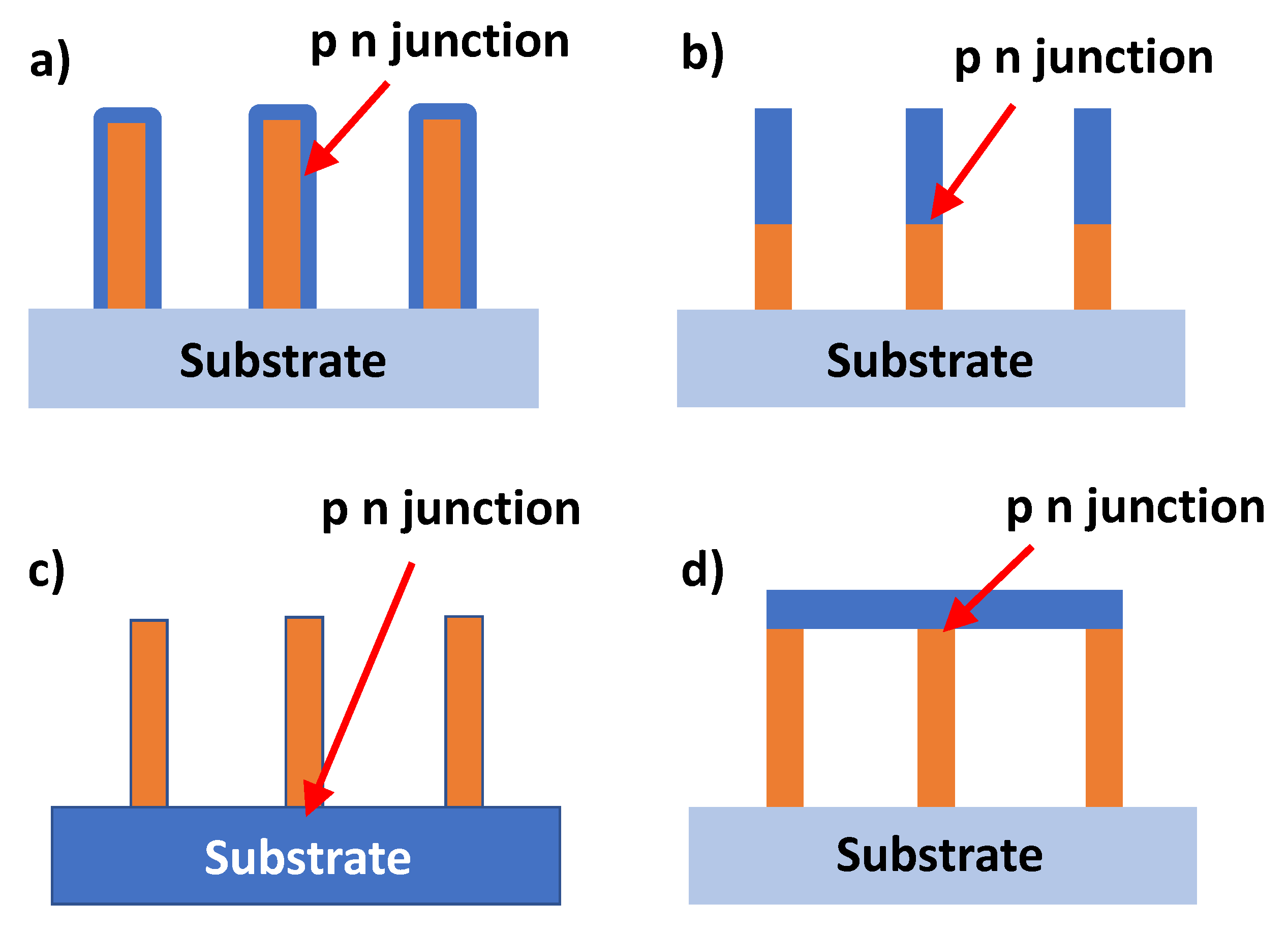

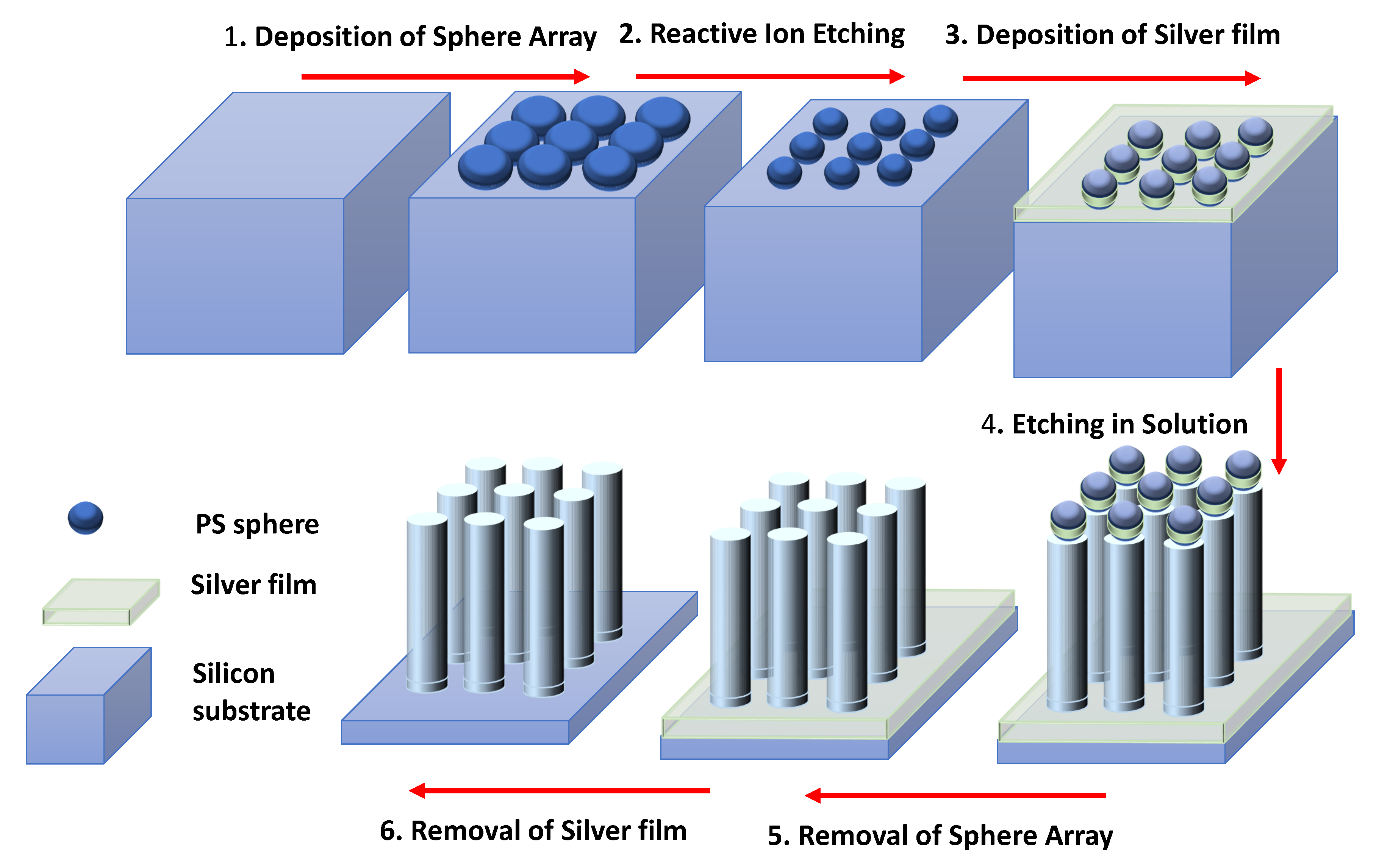
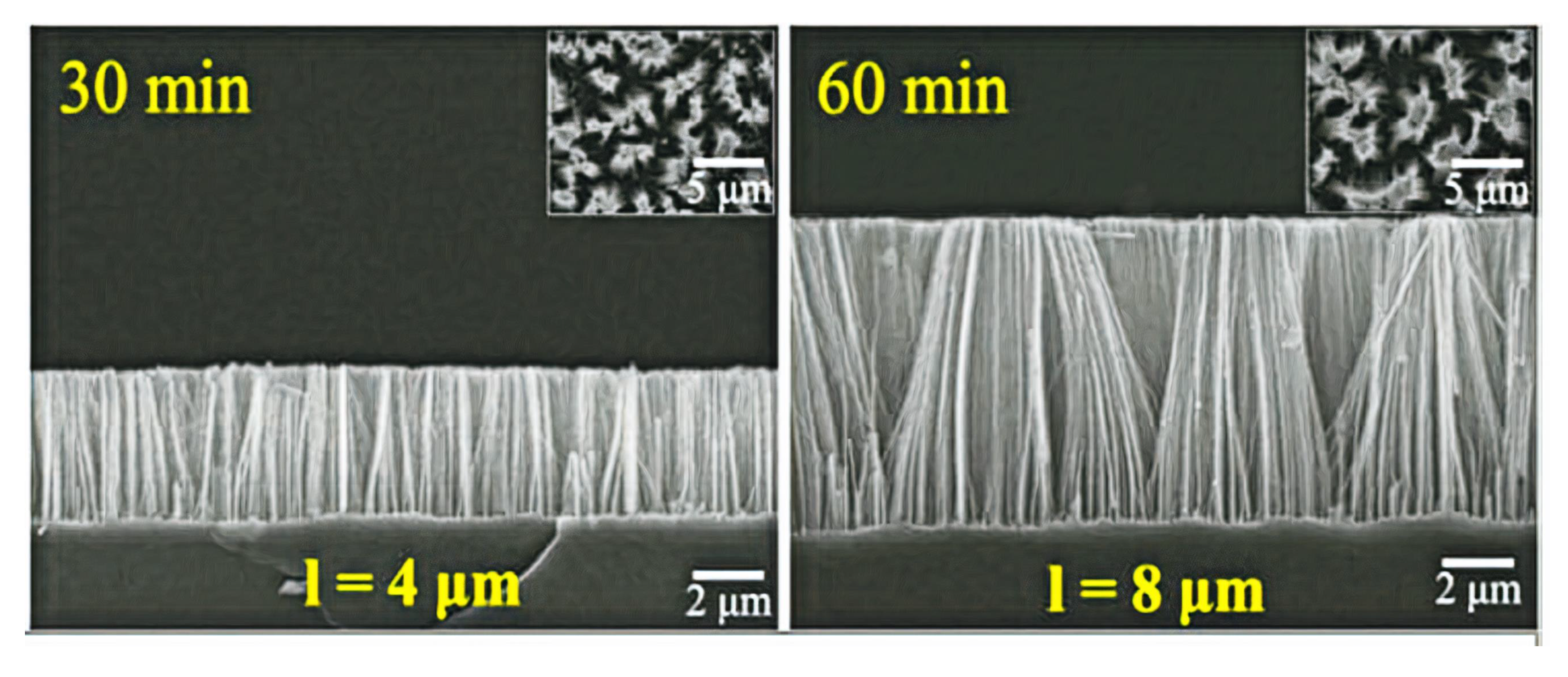
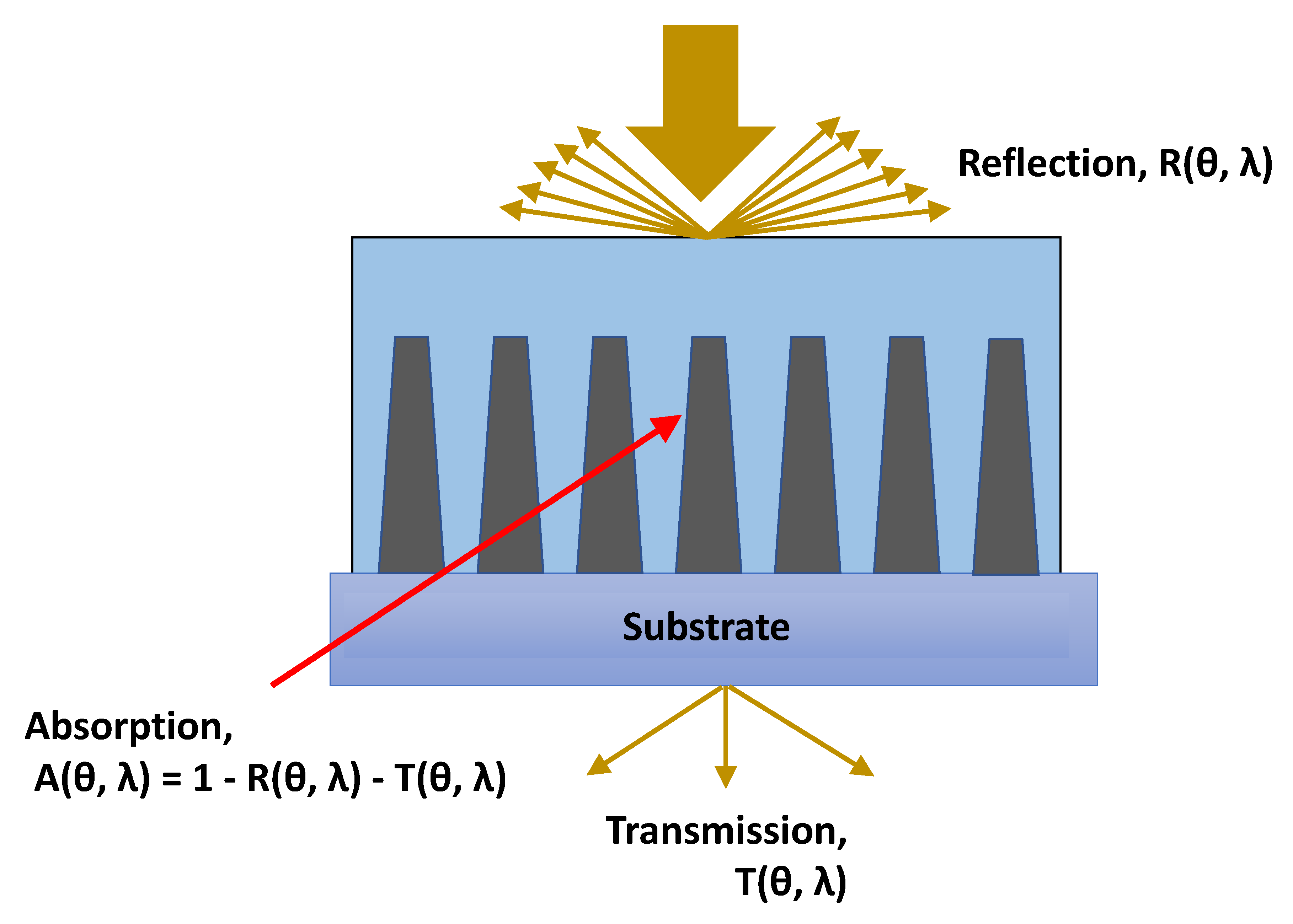
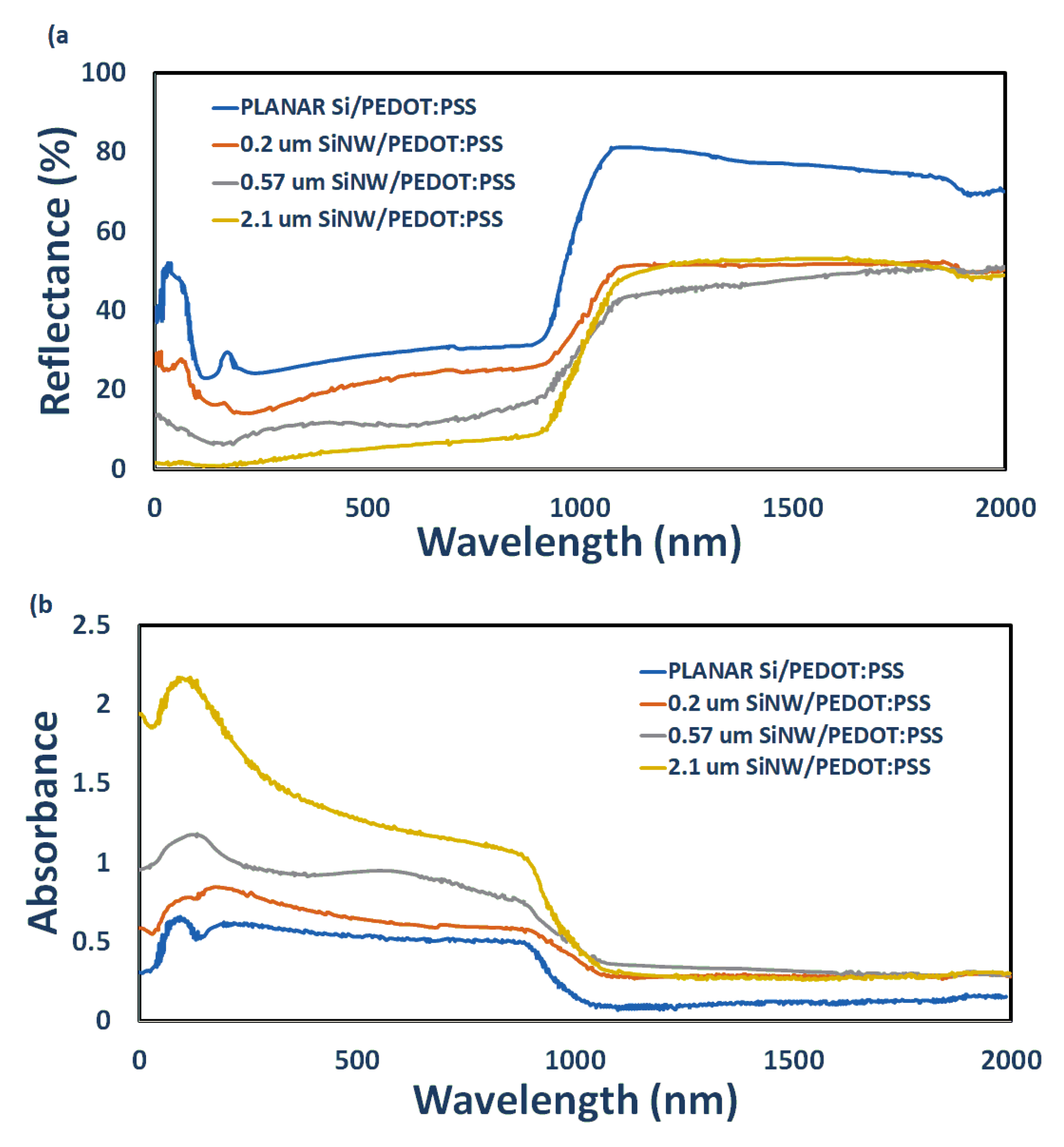
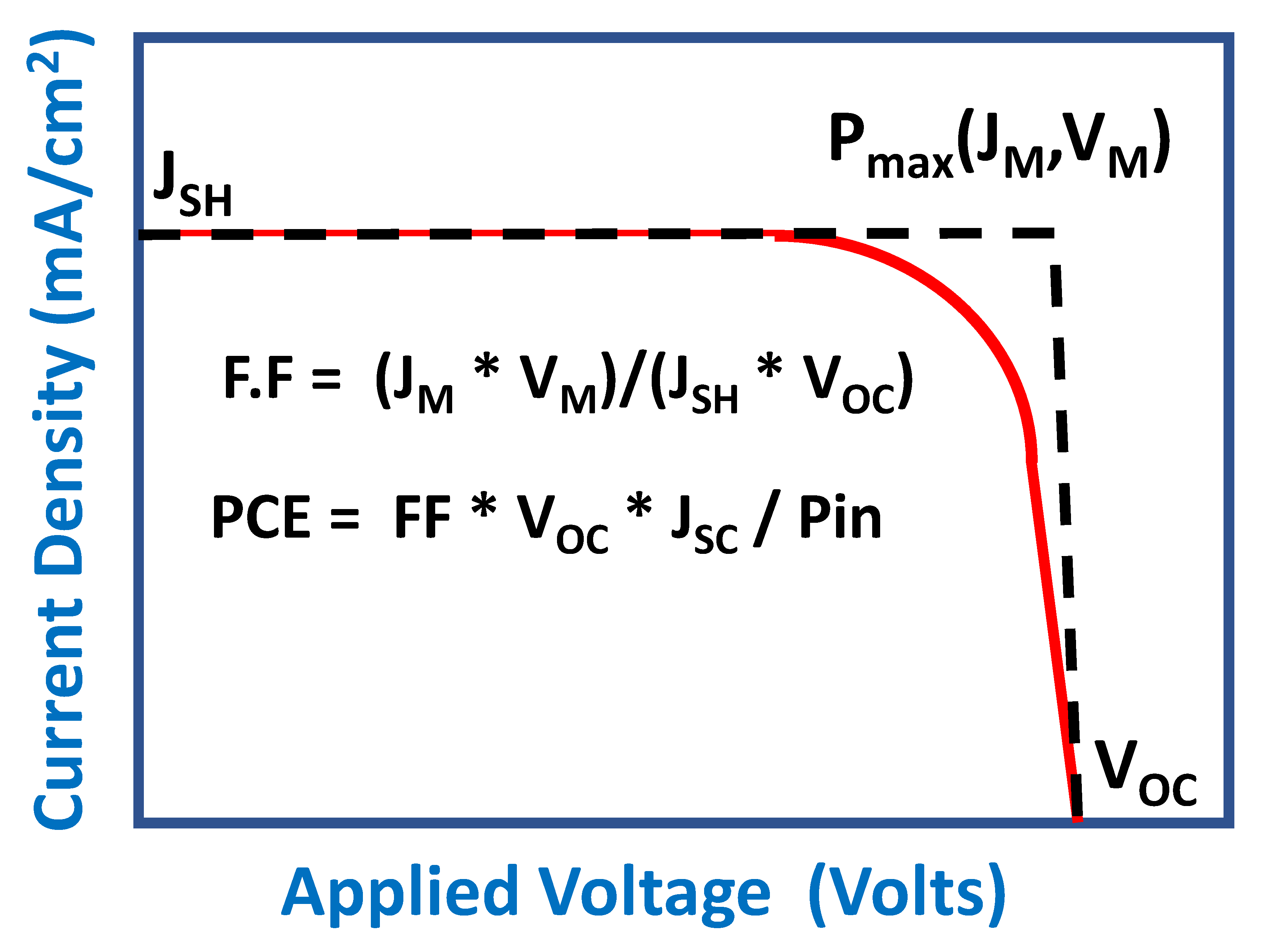
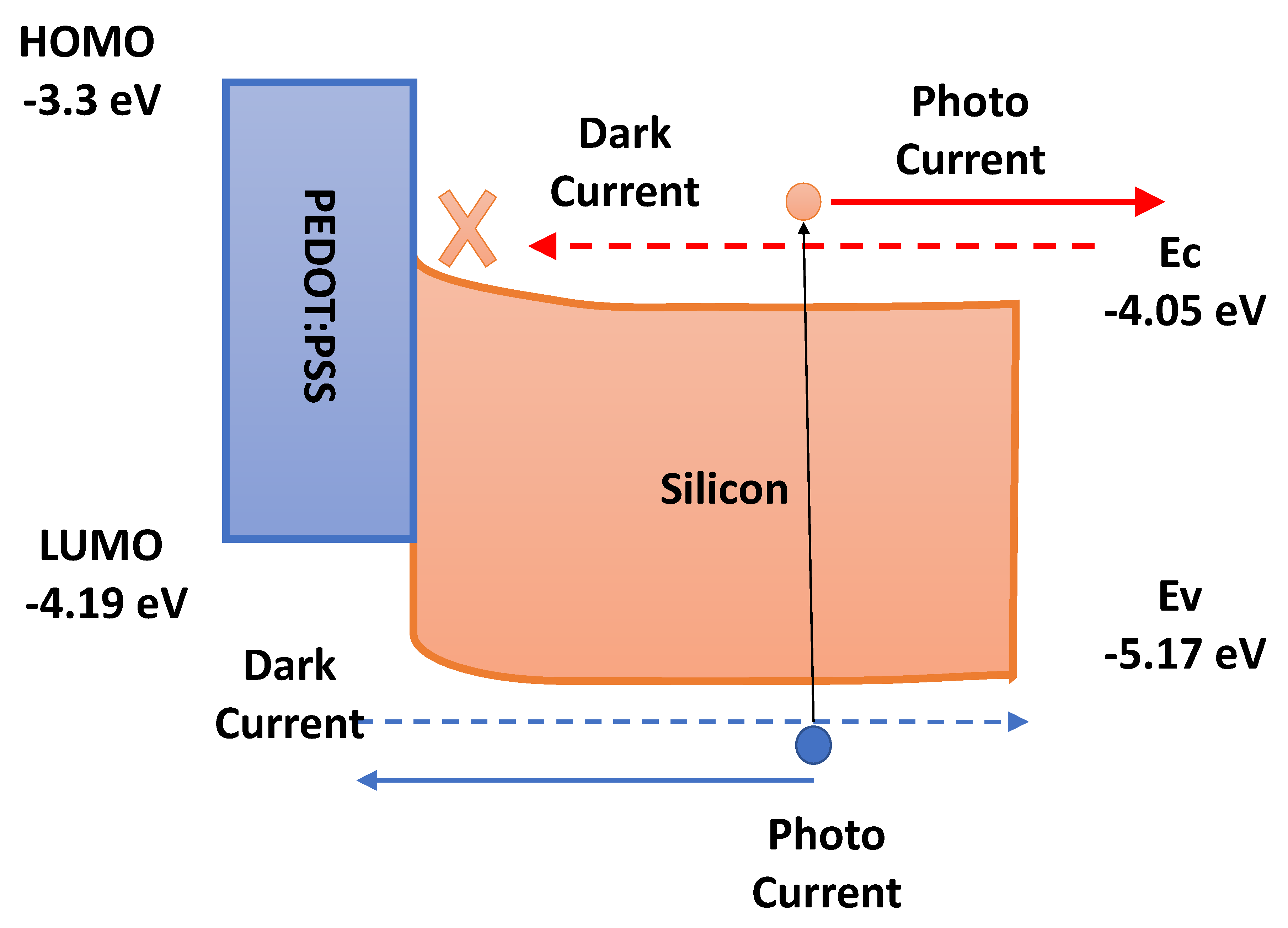
| Efficiency | Year | Researcher | SiNW | Open-Circuit Voltage () | Short-Circuit Current ( ) | Fill-Factor FF | Reference |
|---|---|---|---|---|---|---|---|
| 2020 | Gohar Ali et al. | SiNW | 0.63 | 34.45 | 71.5 | [43] | |
| 2016 | Y. Liu et al. | SiNW | 0.636 | 29.89 | 76 | [44] | |
| 2015 | Zhang et al. | SiNW | 0.621 | 32.2 | 68.4 | [49] | |
| 2015 | Yu et al. | SiNW | 0.614 | 30.42 | 76 | [45] | |
| 2013 | Yu et al. | SiNW | 0.59 | 34.86 | 69.35 | [50] | |
| 2019 | Lu et al. | SiNW | 0.53 | 35.32 | 66.12 | [40] | |
| 2011 | Shen et al. | SiNW | 0.527 | 31.3 | 58.8 | [46] | |
| 2013 | Pudsaini et al. | SiNW | 0.53 | 29.5 | 61.2 | [47] | |
| 2016 | Jang et al. | SiNW | 0.49 | 34 | 59 | [51] | |
| 2020 | Anh et al. | SiNW | 0.53 | 26.64 | 64 | [48] |
© 2020 by the authors. Licensee MDPI, Basel, Switzerland. This article is an open access article distributed under the terms and conditions of the Creative Commons Attribution (CC BY) license (http://creativecommons.org/licenses/by/4.0/).
Share and Cite
Moiz, S.A.; Alahmadi, A.N.M.; Aljohani, A.J. Design of Silicon Nanowire Array for PEDOT:PSS-Silicon Nanowire-Based Hybrid Solar Cell. Energies 2020, 13, 3797. https://doi.org/10.3390/en13153797
Moiz SA, Alahmadi ANM, Aljohani AJ. Design of Silicon Nanowire Array for PEDOT:PSS-Silicon Nanowire-Based Hybrid Solar Cell. Energies. 2020; 13(15):3797. https://doi.org/10.3390/en13153797
Chicago/Turabian StyleMoiz, Syed Abdul, A. N. M. Alahmadi, and Abdulah Jeza Aljohani. 2020. "Design of Silicon Nanowire Array for PEDOT:PSS-Silicon Nanowire-Based Hybrid Solar Cell" Energies 13, no. 15: 3797. https://doi.org/10.3390/en13153797
APA StyleMoiz, S. A., Alahmadi, A. N. M., & Aljohani, A. J. (2020). Design of Silicon Nanowire Array for PEDOT:PSS-Silicon Nanowire-Based Hybrid Solar Cell. Energies, 13(15), 3797. https://doi.org/10.3390/en13153797






